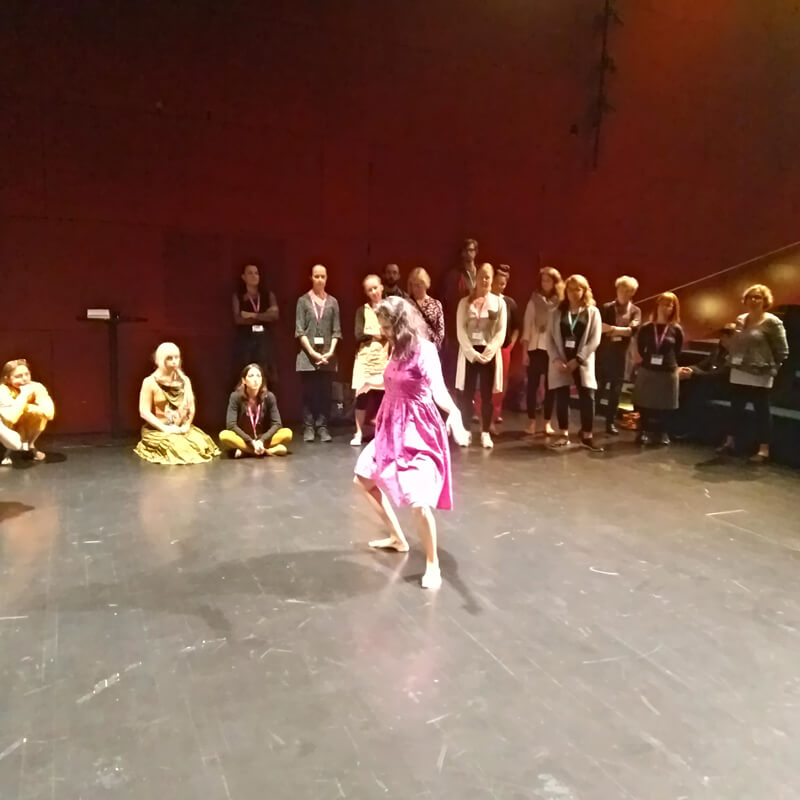Abstract
John Cage’s “Lecture on Nothing” (Cage 1996) is written to be performed as he clearly indicates in the preface (Ibid. p. 6). Through a semantic and sonic engagement with this lecture-performance, our aim was to bridge text and sound, by revisiting the tradition of radiophonic art. We hoped to shape an aesthetic field by offering linguistic inputs not pertaining only to verbal language, but also extending to the language of Indian dance movement, thereby offering a bridge between languages and presentation practices. Thus, CARPA6 with its theme “Artistic Research Performs and Transforms: Bridging Practices, Contexts, Traditions & Futures” provided a befitting frame for this exploration.
– – –
Our participatory performance revisits John Cage’s “Lecture on Nothing”. We draw from our performances of this Lecture as a bilingual simultaneous reading combined with an explorative spatial choreography. Referring to the history of radiophonic art, a bilingual simultaneous reading technique exploits two-channel stereophonic sound transmission and projection. Synchronously, it carries the metaphor of multiple parallel strands of information in our surrounding. We regard this activity not so much as a novel interpretation for the audience but as an experiential engagement with the text by the audience, including ourselves. Portable loudspeaker sculptures that emit textual meta-layers to the Lecture will complement our voices and moving bodies. The spectators are invited to take on the portable speakers based on ad hoc instructions that are part of the meta-layers themselves. Instructions may involve moving in a certain direction or turning around, thus directing the sound, or passing on the speaker to somebody else. The distribution of the text among the human and loudspeakers is determined algorithmically.
For the discussion, the participants will be invited to maintain their roles in the social and technical framework that emerged. We wish to collaboratively experience the residue of the performance rather than pursuing the usual post-presentation meta-discourse.
We aim to perform and transform text through sonic and spatial research. The poetic quality of Cage’s Lecture (maintained in Jandl’s congenial translation) and its structure supports our experiment, which in turn challenges the epistemic potential of the text. We explore the relation of human speakers and loudspeakers, the dynamic interplay of sonics and semantics, its effect on communication and how this shapes space. We require openness for improvisation that transforms the audience into performers, challenging both roles and shaping a participatory field from the shared aesthetic experience.
My reflections
Building on what we intended to create as outlined in our abstract, and in some parts contrasting our expectations, I now note some reflections on the actual performance at CARPA6 Helsinki, on 30th Aug 2019. To begin with, my request to the audience to shift from their auditorium chairs to the “stage” was unusual and surprising to the them. Nonetheless, barring one or two persons, all others paid heed to my request and inhabited the performance space. As I walked down the stairs of the auditorium performing, reading, it provided a shift in perspective since the audience perceived me from or within the performance space, rather than without (which was the case for almost all other presentations at the conference). Since we promised a bilingual reading of the text, I used some Indian classical dance movements as a movement language, coupled with the English text.

Further, as I introduced a portable speaker with my collaborator, Martin Rumori’s voice reading the text in a different language (German), a concept we built on from the radioplay tradition, the others once again contemplated a spatial shift as to where they should face: the empty auditorium chairs, me moving around on the stage, or the static speaker. However, they slowly became comfortable with co-existing in and co-shaping the space with me, all of us moving unpredictably. This also affected my voice projection and intonation in creating the sound space, and their changed perception of the sound by being in different parts of the room.
A second step to invite everyone to become co-performers with me and Martin’s voice was to hand over the speaker to the audience, so they may experience the sound in a yet another mode. Additionally, they were asked to pass the speaker to someone else, thus giving more people a chance to actively be a part of the performance and shape the sound space. However, there was a little reluctance to accept the speaker, which perhaps was viewed as assuming some sort of responsibility. Also, since most participants chose to sit on the floor rather than move around, the speaker did not travel much distance – a feature which could shape the sound space more dramatically. Nevertheless, this was still intact with the impulse of John Cage’s “Lecture on Nothing” – to allow the aesthetics and space to be shaped differently each time, depending on those who participate in the space.
Once I marked the end of my reading by sitting in a chair in the auditorium, the space was opened for questions and comments. As I continued with Cage’s prepared answers, the audience yet again had to shift their perception and role to figure out what was happening. After the six prepared answers, everyone agreed not to have a typical feedback, questions or discussion in order to hold the space between us as was created by the text and the sound.
A short video documentation of this sonic and semantic participatory exploration can be found here: http://janhavidhamankar.com/carpa-6-cage-performance/
Reference
Cage, John. 1996. “Lecture on Nothing.” In Silence, 6–35. Frankfurt am Main: Suhrkamp Verlag.
Janhavi Dhamankar
Janhavi Dhamankar is a philosopher and a performer of Indian classical dance. Her current research explores how empathy shapes integration of minorities and the meeting ground for Social Sculpture, Performance Philosophy, and Artistic Research.
Martin Rumori
Martin Rumori is an artist-researcher in the field of sound installations, performance, and auditory environments. In his explorations, he frequently consults field recordings, semi-narrative speech, and anecdotal residues of everyday life.